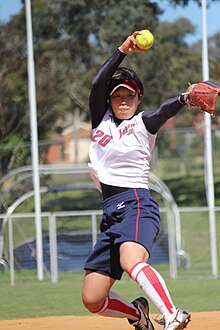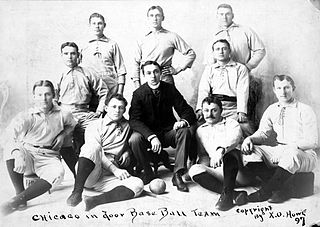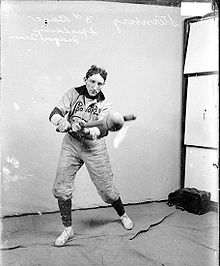
A | B | C | D | E | F | G | H | CH | I | J | K | L | M | N | O | P | Q | R | S | T | U | V | W | X | Y | Z | 0 | 1 | 2 | 3 | 4 | 5 | 6 | 7 | 8 | 9
 A pitcher about to deliver a fastpitch (windmill pitch), where the ball is released while the hand is primarily below the ball | |
| Highest governing body | World Baseball Softball Confederation |
|---|---|
| First played | 1887, United States |
| Characteristics | |
| Contact | Limited |
| Team members | 2 teams of 9 or 10 |
| Equipment |
|
| Presence | |
| Olympic | 1996–2008, 2020 |
| World Games | 1981, 1985 Invitational: 2009–2013 |
Softball is a sport similar to baseball, and it is played with a larger ball on a smaller field and with only underhand pitches (where the ball is released while the hand is primarily below the ball) permitted. Softball is played competitively at club levels, the college level, and the professional level. The game was first created in 1887 in Chicago by George Hancock.
There are two rule sets for softball generally: slow pitch softball and fastpitch. Slow pitch softball is commonly played recreationally, while women's fastpitch softball is a Summer Olympic sport and can be played professionally.
Depending on the variety being played and the age and gender of the players, the particulars of the field and equipment will also vary. While distances between bases of 60 feet are standard across varieties, the pitcher's plate ranges from 35 to 43 feet away from home plate, and the home run fence can be 220 to 300 feet away from home plate.[1] The ball itself is typically 11 or 12 inches (28 or 30 centimetres) in circumference, though this also depends on specifics of the competition. Softball rules vary in certain aspects from those of baseball. The game moves at a faster pace than traditional baseball due to the field being smaller and the bases and the fielders being closer to home plate. Softball is pitched underhand from flat ground.
History

The earliest known softball game was played in Chicago, Illinois, on Thanksgiving Day, 1887. It took place at the Farragut Boat Club at a gathering to hear the outcome of the Yale University and Harvard University football game.[2] When the score was announced and bets were settled, a Yale alumnus threw a boxing glove at a Harvard supporter. The Harvard fan grabbed a stick and swung at the rolled up glove.[3] George Hancock, a reporter there, called out "Play ball!" and the game began, with the boxing glove tightened into a ball, a broom handle serving as a bat. This first contest ended with a score of 41–40.[4] The ball, being soft, was fielded barehanded.[5][6]
Hancock is credited as the game's inventor for his development of a 17" ball and an undersized bat in the next week. The Farragut Club soon set rules for the game, which spread quickly to outsiders. Envisioned as a way for baseball players to maintain their skills during the winter, the sport was called "Indoor Baseball".[7] Under the name of "Indoor-Outdoor", the game moved outside in the next year, and the first rules were published in 1889.[7]

In 1895 Lewis Rober, Sr. of Minneapolis organized outdoor games as exercise for firefighters;[8] this game was known as kitten ball (after the first team to play it), lemon ball, or diamond ball.[9] Rober's version of the game used a ball 12 inches (30 cm) in circumference, rather than the 16-inch (41 cm) ball used by the Farragut club, and eventually the Minneapolis ball prevailed, although the dimensions of the Minneapolis diamond were passed over in favor of the dimensions of the Chicago one. Rober may not have been familiar with the Farragut Club rules. Fire Station No. 19 in Minneapolis, Rober's post from 1896 to 1906, was listed on the National Register of Historic Places in part for its association with the sport's development.[10] The first softball league outside the United States was organized in Toronto, Ontario, in 1897.
The name "softball" dates back to 1926. The name was coined by Walter Hakanson of the YMCA[4] at a meeting of the National Recreation Congress.[11] (In addition to "indoor baseball", "kitten ball", and "diamond ball", names for the game included "mush ball", and "pumpkin ball".[4]) The name softball had spread across the United States by 1930.[11] By the 1930s, similar sports with different rules and names were being played all over the United States and Canada. A tournament held in 1933 at the Chicago World's Fair spurred interest in the game. By 1936, the Joint Rules Committee on Softball had standardized the rules and naming throughout the United States.[12]
Sixteen-inch softball, also sometimes referred to as "mush ball" or "super-slow pitch" (although the ball is not soft at all), is a direct descendant of Hancock's original game. Defensive players are not allowed to wear fielding gloves. Sixteen-inch softball is played extensively in Chicago,[13] where devotees such as newspaper columnist Mike Royko consider it the "real" game,[14] and New Orleans. In New Orleans, sixteen-inch softball is called "Cabbage Ball" or "batter ball" and is a popular team sport in area elementary and high schools.
The first cork-centered softball was created in Hamilton, Ontario, Canada, by Emil "Pops" Kenesky.[15]
By the 1940s, fast pitch began to dominate the game. Although slow pitch was present at the 1933 World's Fair, the main course of action taken was to lengthen the pitching distance. Slow pitch achieved formal recognition in 1953 when it was added to the program of the Amateur Softball Association, and within a decade had surpassed fast pitch in popularity.[7]
The first British women's softball league was established in 1953.[7]
The National Softball Hall of Fame and Museum was opened in Oklahoma City, United States, in 1957.
In 1991, women's fast pitch softball was selected to debut at the 1996 Summer Olympics.[4] The 1996 Olympics also marked a key era in the introduction of technology in softball. The IOC funded a landmark bio-mechanical study on pitching during the games.
In 2002, sixteen-inch slow pitch was written out of the International Softball Federation (ISF) official rules, although it is still played extensively in the United States under The Amateur Softball Association of America, or ASA rules.
The 117th meeting of the International Olympic Committee, held in Singapore in July 2005, voted to drop softball and baseball as Olympic sports for the 2012 Summer Olympics.[16] They were reinstated for the 2020 Summer Olympics held in 2021.[17]
Other sanctioning bodies of softball are AAU, NSA, PONY, Babe Ruth League, ASA, ISC, USSSA and Triple Crown.
Overview
Fastpitch softball is played between two teams on a large field, with nine players (in 10u and above; 8u and below is usually played with ten players on a field at once) from one team on the field at a time. Slow-pitch softball is played with ten fielders but can be played with nine if needed.
The softball field is usually composed of a dirt or brick dust infield that contains the shape and running areas of a diamond and a grass outfield. However, the field can consist of other solid and dry surfaces such as artificial turf or asphalt. There are four bases on the infield: First base, second base, third base, and home plate. The bases are arranged in a square and are typically 60 feet (18 m) apart. Near the center of this square is the pitcher's circle, and within the circle is the "rubber", a small flat rectangular plate a foot and a half in length. The rubber distance from the plate in fastpitch can be as short as 35 feet for 10u players up to 43 feet for ages 14 and older.[18] In slow pitch softball, the rubber distance can be 43, 46 or 50 feet depending on age level and the league one is playing in.
The object of the game is to score more runs (points) than the other team by batting (hitting) a ball into play and running around the bases, touching each one in succession. The ball is a sphere of light material, covered with leather or synthetic material. It is 11 to 12 inches (28–30 cm) (or, rarely, 16 in or 41 cm[19]) in circumference. The game is officiated by one or more neutral umpires. Players and umpires are generally free to ask for a brief stoppage at any time when the ball is not in play (called a time out), or immediately following a play once its outcome is clear.
The game is played in usually seven innings. Each inning is divided into a top half, in which the away team bats and tries to score runs, while the home team occupies the field and tries to record three outs; then a bottom half, when the teams' roles are reversed. Some leagues play with a reduced number of innings or with a time limit, rather than the traditional seven innings.
To start play, the offense sends a batter to home plate. The batting order must be fixed at the start of the game, and players may not bat out of turn. The defense's pitcher stands atop the rubber and pitches the ball towards home plate using an underhand motion. In fast pitch, the pitcher is allowed to take one step back prior to releasing the ball during the forward movement. The batter attempts to hit the pitched ball with a bat, a long, round, smooth stick made of wood, metal or composite. If the pitcher throws three strikes against a batter, then the batter is out and the next batter in the order comes up to bat. A strike is recorded any time a batter swings at and misses a pitch or when a batter hits a ball foul (out of play). A strike is also recorded any time the batter does not swing at a pitch that crosses home plate within an area known as the strike zone. In fast pitch, to be within the strike zone, the pitch must cross over home plate, and as it crosses it must be above the knees and slightly below the shoulders (roughly the armpit or the shirt logo). The strike zone therefore varies from batter to batter. In slow pitch, the ball must land on a carpet or marked area behind the plate, therefore standardizing the strike zone. A pitch outside the strike zone is a ball. If the batter reaches four balls, the batter is awarded the first base in what is known as a "walk". The umpire behind home plate is the sole arbiter of balls and strikes. A foul ball may or may not result in a strikeout dependent upon what association and local league rules. However, bunting a foul ball does result in a strikeout. In some associations and leagues, bunting is not allowed and results in an out. Also, if a player has two strikes, swinging and partially hitting the ball can result in an out if the catcher manages to catch the tipped ball.
The batter attempts to swing the bat and hit the ball fair (into the field of play). After a successful hit the batter becomes a base runner (or runner) and must run to first base. The defense attempts to field the ball and may throw the ball freely between players, so one player can field the ball while another moves to a position to put out the runner. The defense can tag the runner, by touching the runner with the ball while the runner is not on a base. The defense can also touch first base while in possession of the ball; in this case it is sufficient to beat the batter to first base and an actual tag of the batter is unnecessary. A runner is said to be "thrown out" when the play involves two or more defensive players. Runners generally cannot be put out when touching a base, but only one runner may occupy a base at any time and runners may not pass each other. When a ball is batted into play, runners generally must attempt to advance if there are no open bases behind them; for example, a runner on first base must run to second base if the batter puts the ball in play. In such a situation, the defense can throw to the base that the lead runner is attempting to take (a force out), and the defense can then also throw to the previous base. This can result in a multiple-out play: a double play is two outs, while a triple play, a very rare occurrence, is three outs. Runners with an open base behind them are not forced to advance and do so at their own risk; the defense must tag such runners directly to put them out rather than tagging the base.
A ball hit in the air and caught before hitting the ground, in fair or foul territory, puts the batter out. A fly ball is a ball hit high and deep, a pop fly is a ball hit high but short, and a line drive is a ball hit close to the horizontal. After the catch, runners must return to their original bases; if the defense throws the ball to that base before the runner returns, the runner is out as well, resulting in a double play. A runner who remains on the base until the ball is touched, or returns to the base (tags up) after the catch, may try to advance to the next base, at the risk of being tagged out between bases. As in baseball, the infield fly rule applies in some game situations to prevent the defense from recording multiple force outs by deliberately dropping an easy catch.
Offensive strategy is mostly just to hit the ball skillfully to let the batter reach base and advance other runners around the bases to score runs. The count of balls and strikes indicates how aggressive the batter should be. The offense may try to sacrifice, with the batter deliberately making an out in order to advance runners. Defensive strategy is more complex, as particular situations (number of outs and positions of base-runners) and particular batters call for different positioning of fielders and different tactical decisions. The defense may decide to allow a run if it can achieve one or multiple outs.
Playing field

The playing field is divided into fair territory and foul territory. Fair territory is further divided into the infield, and the outfield.
The field is defined by foul lines that meet at a right angle at home plate. The minimum length of the baselines varies classification of play (see below for official measurements). A fence running between the baselines defines the limits of the field; distance from home plate to the fence varies by field. The widest part of the field is the distance between the foul poles, which are erected where the foul lines meet the fence, and are about 310 to 420 feet (94 to 128 m) apart depending on the length of the foul lines.
Home plate is one corner of a diamond with bases at each corner. The bases are cushions 15 inches (38 cm) square, of canvas or a similar material, and not more than 5 inches (13 cm) thick. The bases are usually securely fastened to the ground. The bases are numbered counter clockwise as first base, second base, and third base. Often, but not always, outside first base (that is, in foul territory) and adjacent and connected to it, there is a contrast-colored "double base" or "safety base" intended to prevent collisions between the first baseman and the runner. The runner runs for the foul portion of the double base after hitting the ball while the fielding team tries to throw the ball to the fair portion before the runner reaches the safety base. However, not all softball diamonds have these safety bases and they are much more common in women's softball than in men's. The double base is required in the U-18 Women's Softball World Cup.
The infield consists of the diamond and the adjacent space in which the infielders (see below) normally play. The outfield is the remaining space between the baselines and between the outfield fence and the infield. The infield is usually "skinned" (dirt), while the outfield has grass in regulation competitions.
Near the center of the diamond is the pitching plate, or colloquially "rubber". In fastpitch, a circle 16 feet (4.9 meters) in diameter known as the pitching circle is market around the pitching plate.[20]
A field is officially required to have a warning track between 15 and 12 feet (4.6 and 3.7 meters) from the outfield fence. However, if the game is being played on a field larger than required, no warning track is required before the temporary outfield fencing.
Located in foul territory outside both baselines are two coach's boxes. Each box is behind a line 15 feet (4.6 meters) long located 12 feet (3.7 meters) from each baseline.
Official baseline dimensions
| Fast pitch | Slow pitch | Wheelchair |
|---|---|---|
| 60 feet (18.29 m) | 60 to 70 feet (18.29 to 21.34 m) depending on the association and level of play | 50 feet (15.24 m) |
Pitching distances
| Adult[21] | Youth | Kids | Wheelchair | ||
|---|---|---|---|---|---|
| 13–19 years | 10–12 years | 7–9 years | <7 years | ||
| 50 feet (15.24 m) | 50 feet (15.24 m) | 46 feet (14.02 m) | 43 feet (13.11 m) | Coach pitch | 28 feet (8.53 m) |
